![]()
![]()
![]()
Use LEFT and RIGHT arrow keys to navigate between flashcards;
Use UP and DOWN arrow keys to flip the card;
H to show hint;
A reads text to speech;
109 Cards in this Set
- Front
- Back
|
In the PNS there are two different pathways, what are they?
|
Afferent (sensory neurons)
Efferent (Terminate on effectors) |
|
|
There are two different kinds of efferent pathways, what are they?
|
Somatic motor pathways (mostly voluntary control of skeletal muscle)
Autonomic pathways (mostly involuntary control) |
|
|
What are the two different divisions of the autonomic pathway?
|
Sympathetic
Parasympathetic |
|
|
Where are the cell bodies of motor neurons located, and what kind of neuron are they?
|
spinal cord or brainstem
multipolar |
|
|
True or False: motor axons are myelinated?
|
True
|
|
|
Motor axons release ________ onto ________ receptor.
|
Acetylcholine
Nicotinic cholenergic |
|
|
What are the two primary neurotransitters of the PNS?
|
NE and ACh
|
|
|
What kind of receptors does NE use?
|
Alpha adrenergic receptors
Beta adrenergic receptors |
|
|
What kind of receptors does ACh use?
|
muscarinic cholinergic receptors
nicotinic cholinergic receptors |
|
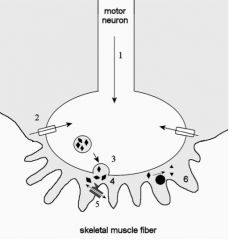
Describe #1
|
Action potential arrives at the synaptic knob (axon terminus)
|
|
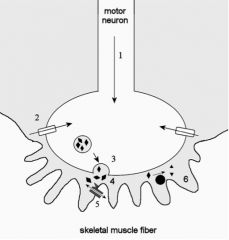
Describe #2
|
Ca++ channels open, Ca++ folows into the axon terminus down its electrochemical gradient.
|
|
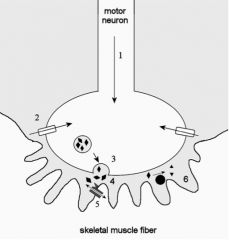
Describe #3
|
Acetylcholine is exocytosed into the synapse
|
|

Describe #4
|
ACh diffuses across the synapse and binds to nicotinic cholinergic receptors
|
|

Describe #5
|
Nicotinic receptor allows Na+ influx and K+ efflux. Overall, Na+ influx exceeds K+ efflux and the uscle cell depolarizes.
|
|
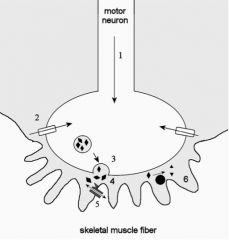
Describe #6
|
Acetylcholine is degraded by the enzyme AChE that is found in the synapse.
|
|
|
Where is the cell body for the preganglionic neuron located?
|
The CNS
|
|
|
Where is the synapse of the preganglionic and post ganglionic neuron located?
|
Occurs in the autonomic ganglia, outside of the CNS
|
|
|
What do the postganglionic neurons synapse with?
|
Target tissue (effector organ)
|
|
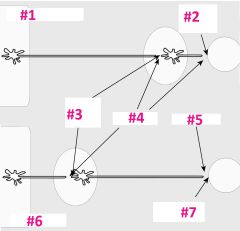
Describe #1-4
|
1) Parasympathetic
3) Cholinergic nicotinic receptors 4) Acetylcholine 2) Cholinergic Muscarinic Receptors |
|
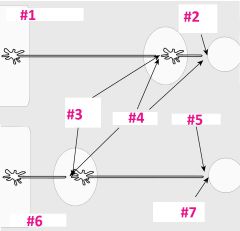
Describe #1-4
|
1) Parasympathetic
3) Cholinergic nicotinic receptors 4) Acetylcholine 2) Cholinergic Muscarinic Receptors |
|
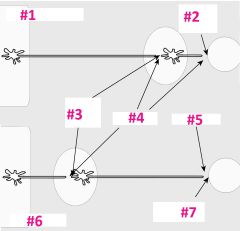
Describe #3-7
|
6) Symthathetic
3) Cholinergic nicotinic receptors 4) Acetylcholine 5) Norepinephrine 7) Adrenergic alpha or beta receptors |
|
|
What are the CNS exit points for the Parasympathetic Pathways?
|
Cranial nerves (including cranial nerve X, the Vagus) and sacral spinal nerves (S2-S4)
|
|
|
What are the CNS exit points for the Sympathetic Pathways?
|
Thoractic spinals nerves (T1-T12) and lumbar spinal nerves (L1 & L2)
|
|
|
Where is the location of ganglia for the parasympathetic pathway?
|
Parasypathetic ganglia and on target tissue.
|
|
|
Where is the location of ganglia for the sympathetic pathway?
|
Sympathetic chain and collateral sympathetic ganglia
|
|
|
What is the general function of the parasympathetic pathway?
|
Rest and digest
|
|
|
What is the general function of the sympathetic pathway?
|
Fight or flight
|
|
|
What effect does the sympathetic system have on the heart?
|
Increases force and rate of contractions
|
|
|
What effect does the parasympathetic system have on the heart?
|
Decreases rate of contraction
|
|
|
What effect does the sympathetic system have on the blood vessels?
|
Vasoconstriction (a1) and vasodilation (b2)
|
|
|
What effect does the parasympathetic system have on the blood vessels?
|
none
|
|
|
What effect does the sympathetic system have on the bronchioles of the lung?
|
dilation
|
|
|
What effect does the parasympathetic system have on the bronchioles of the lung?
|
constriction
|
|
|
What effect does the sympathetic system have on the digestive tract motility?
|
decreased
|
|
|
What effect does the parasympathetic system have on the digestive tract motility?
|
increased
|
|
|
What effect does the sympathetic system have on the digestive tract secretions?
|
Inhibited
|
|
|
What effect does the parasympathetic system have on the digestive tract secretions?
|
stimulated
|
|
|
What effect does the sympathetic system have on the pancreas exocrine function?
|
inhibited
|
|
|
What effect does the parasympathetic system have on the pancreas exocrine function?
|
stimulated
|
|
|
What effect does the sympathetic system have on the salivary glands?
|
mucous secretion
|
|
|
What effect does the parasympathetic system have on the salivary glands?
|
watery secretion
|
|
|
What effect does the sympathetic system have on the bladder wall muscle?
|
relaxation
|
|
|
What effect does the parasympathetic system have on the bladder wall muscle?
|
contraction
|
|
|
What effect does the sympathetic system have on the bladder sphincter?
|
contraction
|
|
|
What effect does the parasympathetic system have on the bladder sphincter?
|
relaxation
|
|
|
What effect does the sympathetic system have on the penis?
|
Ejaculation
|
|
|
What effect does the parasympathetic system have on the penis?
|
erection (vasodilation)
|
|
|
What effect does the sympathetic system have on the uterus?
|
Contraction (a1) and relaxation (B2)
|
|
|
What effect does the parasympathetic system have on the uterus?
|
none
|
|
|
What effect does the sympathetic system have on the sweat glands?
|
Secretion
|
|
|
What effect does the parasympathetic system have on the sweat glands?
|
Secretion
|
|
|
What effect does the sympathetic system have on the piloerector muscles?
|
contraction
|
|
|
What effect does the parasympathetic system have on the piloerector muscles?
|
none
|
|
|
What effect does the sympathetic system have on the iris (pupil) of the eye?
|
Dilation (radial muscle contracts)
|
|
|
What effect does the parasympathetic system have on the iris (pupil) of the eye?
|
Constricts (cicrcular muscle contracts)
|
|
|
What effect does the sympathetic system have on the lens of the eye?
|
Ciliary muscle relaxes (small effect)
|
|
|
What effect does the parasympathetic system have on the lens of the eye?
|
Ciliary muscles contract (near vision)
|
|
|
What effect does the sympathetic system have on the liver?
|
Glycogen catabolism, gluconeogenesis, fat catabolism
|
|
|
What effect does the parasympathetic system have on the liver?
|
none
|
|
|
The Adrenal medula consists of modified ________ ________ neurons that secrete ___ and ___ into the blood.
|
Postganglionic
Sympathetic E NE |
|
|
What kind of receptors do E and NE target throughout the body?
|
Alpha and Beta adrenergic receptors
|
|
|
Why is it important that the adrenal medulla allows catecholamines to stimulate adrenergic receptors without direct neural connections to the respective target tissue?
|
So the body can activate a systemic sympathetic response quickly.
|
|
|
The Adrenal medula consists of modified ________ ________ neurons that secrete ___ and ___ into the blood.
|
Postganglionic
Sympathetic E NE |
|
|
What kind of receptors do E and NE target throughout the body?
|
Alpha and Beta adrenergic receptors
|
|
|
Why is it important that the adrenal medulla allows catecholamines to stimulate adrenergic receptors without direct neural connections to the respective target tissue?
|
So the body can activate a systemic sympathetic response quickly.
|
|
|
How many neurons are inovlved in the efferent parasympathetic pathway?
|
Two
|
|
|
What are the effector organs in the parasympathetic pathway?
|
Cardiac and smooth muscle
Glands |
|
|
What is the neurotransmitter at the final target in the efferent parasympathetic pathway?
|
ACh
|
|
|
What effect does the efferent parasympathetic system have on the target tissue?
|
Excitation or inhibition
|
|
|
What kind of control does the efferent parasympathetic system on target tissue?
|
Primarily involuntary
|
|
|
In the efferent parasympathetic system what components are found outside of the CNS?
|
Preganglionic axons,
ganglia, post ganglionic neurons |
|
|
How many neurons are there in the efferent sympathetic pathway?
|
Two
|
|
|
What are the effector organs in the efferent sympathetic pathway
|
Cardiac and smooth muscle
glands |
|
|
In the efferent sympathetic pathway, what neurotransmitter is at the final target?
|
NE
|
|
|
In the efferent sympathetic pathway, what receptor is at the final target?
|
A and B adrenergic
|
|
|
What effect does the efferent sympathetic pathway have on the target tissue?
|
excitation or inhibition
|
|
|
What kind of control does the efferent sympathetic system use?
|
Primarily involuntary
|
|
|
What components of the efferent sympathetic pathway are found outside of the CNS?
|
Preganglionic axons
Ganglia Postganglionic neurons |
|
|
How many neurons are there in the efferent adrenal pathway?
|
One
|
|
|
What effector organs are involved in the efferent adrenal pathway?
|
many
|
|
|
In the efferent adrenal pathway, what is the neurotransmitter at the final target?
|
Mostly E, some NE
|
|
|
In the efferent adrenal pathway, what is the receptor at the final target?
|
A and B adrenergic
|
|
|
What effect does the efferent adrenal pathway have on it's target tissues?
|
Excitation or inhibition
|
|
|
What kind of control does the efferent adrenal pathway have on it's target tissue?
|
Primarily involuntary
|
|
|
What components of the efferent adrenal pathway are located outside of the CNS?
|
Preganglionic axons, entire adrenal medulla
|
|
|
How many neurons are involved in the efferent somatic pathway?
|
One
|
|
|
What are the effector organs in the efferent somatic pathway?
|
Skeletal muscle
|
|
|
In the efferent somatic pathway, what is the neurotransmitter at the final target?
|
ACh
|
|
|
In the efferrent somatic pathway, what is the receptor at the final target?
|
Nicotinic cholinergic
|
|
|
What effect does the efferent somatic pathway have on the target tissue?
|
Excitation
|
|
|
What kind of control does the efferent somatic pathway use?
|
primarily voluntary
|
|
|
What components of the efferent somatic pathway are located outside of the CNS?
|
Axons only
|
|
|
What kind of control does the efferent somatic pathway use?
|
primarily voluntary
|
|
|
What do autonomic neuroeffector junctions consist of?
|
synapses between postganlionic parasympathetic and sympathetic neurons and the effector organs that they innervate.
|
|
|
What kind of control does the efferent somatic pathway use?
|
primarily voluntary
|
|
|
What components of the efferent somatic pathway are located outside of the CNS?
|
Axons only
|
|
|
Instead of synaptic knobs (which are present in neuromuscular synapses) at the terminus of the neuroeffector synapses post ganglionic autonomic synapses are produced by:
|
Autonimic varicosities which are swollen regions along the post ganlionic neurons
|
|
|
What do autonomic neuroeffector junctions consist of?
|
synapses between postganlionic parasympathetic and sympathetic neurons and the effector organs that they innervate.
|
|
|
What components of the efferent somatic pathway are located outside of the CNS?
|
Axons only
|
|
|
Neurotransmitter is released from the ________ in neuroeffector synapses.
|
Varicosities
|
|
|
Instead of synaptic knobs (which are present in neuromuscular synapses) at the terminus of the neuroeffector synapses post ganglionic autonomic synapses are produced by:
|
Autonimic varicosities which are swollen regions along the post ganlionic neurons
|
|
|
What do autonomic neuroeffector junctions consist of?
|
synapses between postganlionic parasympathetic and sympathetic neurons and the effector organs that they innervate.
|
|
|
Neurotransmitter is released from the ________ in neuroeffector synapses.
|
Varicosities
|
|
|
Instead of synaptic knobs (which are present in neuromuscular synapses) at the terminus of the neuroeffector synapses post ganglionic autonomic synapses are produced by:
|
Autonimic varicosities which are swollen regions along the post ganlionic neurons
|
|
|
Neurotransmitter is released from the ________ in neuroeffector synapses.
|
Varicosities
|
|
|
Describe the steps for neurotransmitter release in the sympathetic pathway
|
1- action potential arrives
2- Ca++ channels open 3- Exocytosis of NE ito synapse 4- Binging of NE to G-protein linked receptor (a and b adrenergic) 5- NE is reabsorbed into the varicosity and is also lost via diffusion 6- NE is catabolized by MAO in mitochondria |
|
|
Describe the steps for neurotransmitter release in teh parasympathetic pathway
|
1- action potential arrives
2- Ca++ channels open 3- exocytosis of ACh into synapse 4- binding of ACh to G-protein linked receptor (muscarinic) 5- ACh is catabolized by AChE and acetyl is lost via diffusion. 6- Choline is reabsorbed |
|
|
Describe the steps for neurotransmitter release in the sympathetic pathway
|
1- action potential arrives
2- Ca++ channels open 3- Exocytosis of NE into synapse 4- Binding of NE to G-protein linked receptor (a and b adrenergic) 5- NE is reabsorbed into the varicosity and is also lost via diffusion 6- NE is catabolized by MAO in mitochondria |
|
|
Describe the steps for neurotransmitter release in teh parasympathetic pathway
|
1- action potential arrives
2- Ca++ channels open 3- exocytosis of ACh into synapse 4- binding of ACh to G-protein linked receptor (muscarinic) 5- ACh is catabolized by AChE and acetyl is lost via diffusion. 6- Choline is reabsorbed |

